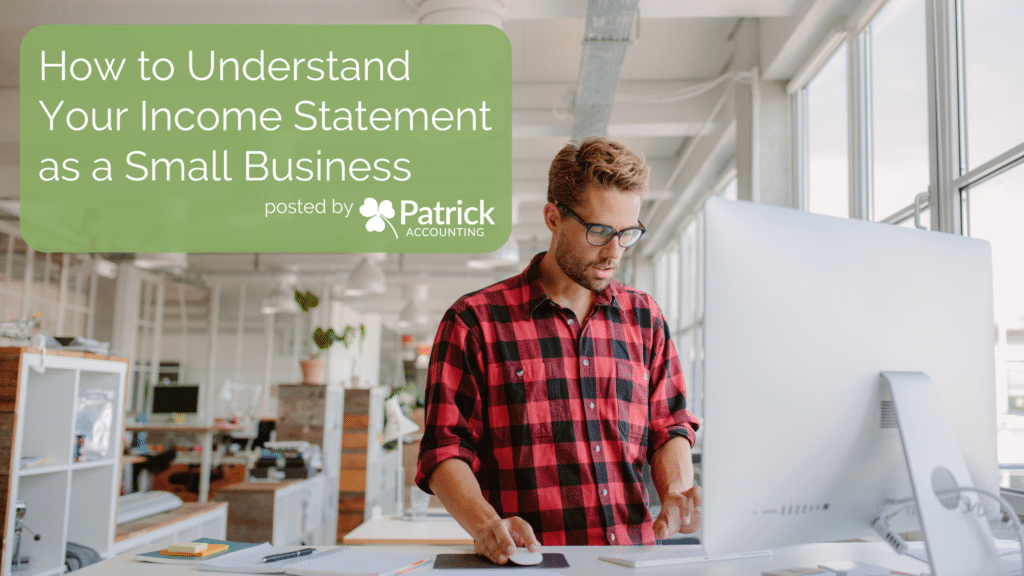How to Understand Your Income Statement as a Small Business
March 15th, 2024 | 4 min. read
By Matt Patrick



The income statement, though seemingly a straightforward calculation, can become a source of stress when it’s cluttered with numerous categories and intricate details.
Understanding all those details is key to making good business choices, but it can be a lot to take in. At Patrick Accounting, we’ve spent twenty years making those tough numbers easy to understand.
In this article, we’re going to walk you through three important parts of your income statement as a small business that you really need to know about to keep your business financially healthy.
What is an Income Statement
Your Income Statement also called a “Profit and Loss Statement” or “P&L”, is actually a very simple formula:
Total Income – Total Expenses = Profit.
It isn’t any more complicated than that.
However, it can look complicated when you begin to add subcategories to the “Income” and “Expenses” parts of the equation. Most (but not all) businesses have several categories of income as well as a number of expense categories. Listed together, they can make for an intimidating spreadsheet full of numbers, but at the end of the day, the equation is still: Total Income – Total Expenses = Profit.
1. The Income Statement Is Absolutely Essential
Snapshot of Financial Health
Think of your income statement as a health check for your business. It shows if you’re making money (which is great!) or if you’re losing it (which is a warning sign). As a small business owner, you need to know how profitable your business is – or isn’t. And, let’s face it, if you’re not profitable…you will have a hard time staying in business.
The Core of Business Decision-Making
This statement isn’t just a bunch of numbers. It’s a story about your business’s day-to-day activities. It helps you decide what’s working and what’s not, guiding you on where to focus your efforts, such as boosting sales, cutting costs, or maybe changing up your products or services.
2. Income Statements Don’t Show Everything About Your Income
Recognizing Revenue
Your income statement shows your earnings, but it’s not telling you when the cash will hit the bank.
For instance, in service industries, revenue is recognized when the service is completed, not when the invoice is sent or payment is expected. This distinction can result in a scenario where your books show a profit, but your bank account doesn’t reflect this because the cash hasn’t been received.
Cash Flow Versus Profit
Seeing a profit on your income statement is good news, but it doesn’t always mean you have that money available. Profit on paper and cash in the bank can be two different things. Knowing the difference helps you plan better and keeps you from spending money that’s not yet in your pocket.
3. Income Statements Don’t Cover All Expense Details
Timing of Expense Recognition
Let’s break down a tricky part of accounting that can confuse many of us who aren’t accountants: when do expenses show up on your income statement? Expenses aren’t always recorded in the period they are paid. For example, the cost of raw materials is recognized when the finished goods are sold, not when the materials are purchased. This can create discrepancies between your cash outlays and the expenses shown on your P&L.
Capital Expenditures and Financing
Imagine you buy a big piece of equipment or a vehicle and pay for it over time. In accounting, you might show the cost of this equipment on your income statement right when you buy it, not spread out over the years you’re paying for it. This can make your profits look smaller, but it might also reduce how much tax you owe that year. On the other hand, sometimes the cost is spread out on the books over many years, even if you finish paying for it sooner.
Since accounting doesn’t always match the expense with the actual cash outlay, it’s important to consider multiple statements to help you see the whole picture.
Key Numbers to Look For on Your P&L
Let’s define what some of the key numbers you need to know really mean.
Revenue
Revenue is the money you bring in every time you sell something. It’s useful to organize this into different categories based on the type of income. For example, a restaurant might separate its revenue into food sales, bar sales, and catering sales. This categorization helps you see where your earnings are coming from.
Cost of Goods Sold (COGS)
COGS includes all the expenses directly linked to producing what you sell. This includes purchases of inventory, freight to ship the inventory, delivery costs, packaging costs, etc.
For a service-based business, instead of parts and inventory, COGS includes expenses related to your production or service team such as hourly wages.
Operating Expenses (OPEX)
Operating Expenses cover everything else it costs to keep the lights on, service your customers, market your business, etc. These expenses, often referred to as overhead, are generally consistent no matter how much you sell.
How Your P&L Can Help Your Small Business
Your P&L does a great job of showing how your business is doing financially over a period of time. It equips you to make better spending decisions and shows you what adjustments could increase profitability. The bottom line is that it gives you the insight you need to make awesome business decisions.
The Power of Three: P&L + Balance Sheet + Cash Flow Statement
Your P&L is just one piece of the puzzle. When you look at it alongside your Balance Sheet and Cash Flow Statement, you get a full picture of your business’s financial health. This trio of financial reports equips you to manage your business with a clear understanding of your financial standing.
Dig Deeper into Your Financial Statements
With a basic understanding of your income statement, you’re hopefully feeling more confident now about the financial health of your business. By dissecting the key elements—revenue, expenses, and profits—you’ve taken a crucial step towards financial mastery. Now, this newfound knowledge may lead you to question: what should I do with my profits?
At the end of the day, we know how challenging it can be to decode the complexities of financial statements. At Patrick Accounting, we don’t just help you understand your income statement; we offer comprehensive financial guidance to empower your business decisions.